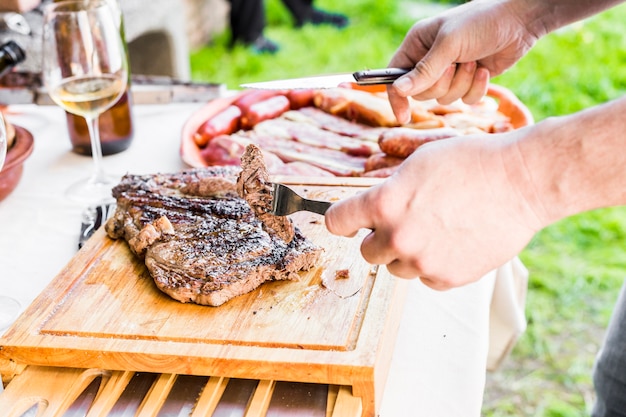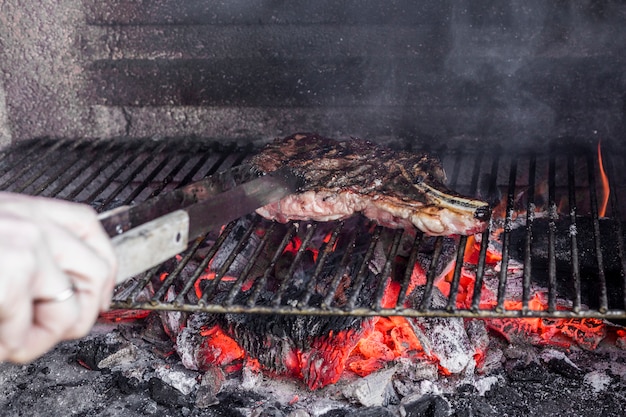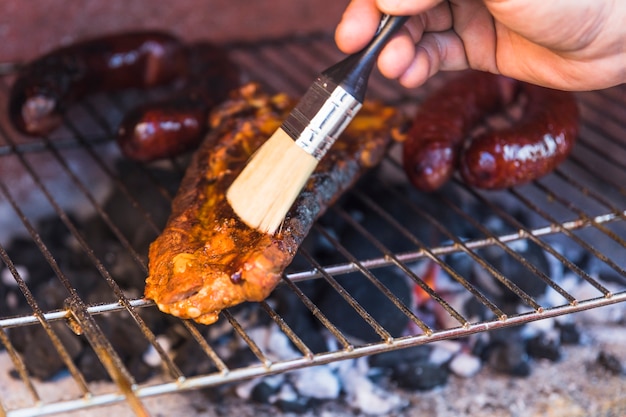Let's be honest, folks, there's something about a perfectly cooked brisket that just elevates a barbecue to another level. It's not just a piece of meat; it's a culinary masterpiece, a testament to patience, skill, and a whole lot of love. I'm talking about brisket so tender it practically melts in your mouth, with a bark so crisp and flavorful it could make angels weep. But I'll admit, it hasn't always been this way for me. I've had my fair share of brisket disasters, dry, tough pieces of meat that left me questioning my grilling abilities. But then came those moments of pure grilling glory, where the aroma alone sent me into a trance, and the first bite was a revelation. It's a journey, and I'm here to guide you through it, sharing all the tips and tricks I've learned along the way. So grab your apron, crank up the grill, and let's embark on this delicious adventure together.
(Part 1) The Brisket: Unveiling the Star of the Show

Before we dive into the grilling process, let's get to know our star ingredient: the brisket. This cut of meat, taken from the breast of a cow, is a real workhorse muscle. Think of all the heavy lifting it does, and you'll understand why it's naturally tough and full of connective tissue. That's where the magic of slow and low cooking comes in. It's the key to transforming this tough muscle into a masterpiece of tenderness. As the brisket cooks slowly, the connective tissue breaks down, turning into luscious gelatin, giving it that melt-in-your-mouth texture we all crave. But there's more to the story.
Decoding the Brisket: Point vs. Flat
A whole brisket is actually composed of two distinct sections: the point and the flat. The point, thicker and more marbled, packs a punch of flavor, but can be a bit tougher. The flat, leaner and more rectangular, tends to be more tender but can sometimes be a tad dry.
Choosing Your Brisket: Point, Flat, or Packer?
Now, the choice is yours! If you crave a richer, more flavorful brisket, go for the point. If you're after a leaner, tender cut, the flat is your best bet. For a true Texan barbecue experience, you can opt for a whole packer brisket, which includes both the point and the flat, offering the best of both worlds.
(Part 2) Selecting and Preparing Your Brisket: A Journey of Flavor

So, you've chosen your brisket. Now, it's time to select the right one and prepare it for grilling.
Finding the perfect brisket: A Guide for the Discerning Griller
Don't just grab any brisket; you want to find a beauty that's ready to shine. Look for a brisket with a generous layer of fat on top - it's crucial for keeping the meat juicy during cooking. The fat should be evenly distributed, with a healthy, white color. Avoid any brisket with dark or discolored fat, as this could indicate poor quality.
Trimming and Prepping: Unlocking the Flavor Potential
Now that you have your chosen brisket, it's time to trim it. You want to remove any excess fat, but don't go overboard. Leave a nice layer of fat on top to ensure a juicy, succulent outcome.
- Removing Excess Fat: Use a sharp knife to carefully trim away any excess fat that's hanging off the brisket. You're aiming for a nice, even layer of fat, not a thick slab that will hinder even cooking.
- Removing the Fat Cap: This layer of fat directly on top of the brisket needs some attention. Use a sharp knife to score the fat cap, making shallow cuts about 1/2 inch apart. This will help the fat render down evenly during cooking and create a beautiful, crispy bark.
- Seasoning: The Art of Enhancing Flavor: This is where things get fun! There are countless ways to season a brisket, but it's your opportunity to add your personal touch. I love a simple rub of salt, pepper, paprika, garlic powder, and onion powder. It's classic for a reason. But feel free to explore! Experiment with your favorite spices and create a rub that reflects your own grilling style.
(Part 3) Setting Up Your Grill: A Stage for Culinary Excellence

Your brisket is ready to go. Now it's time to prepare your grill for the challenge. It's all about creating the perfect environment for slow, even cooking.
Choosing the Right Grill: Your Culinary Weapon of Choice
For a brisket, you want a grill with ample space for even cooking. An offset smoker is ideal, offering a truly authentic barbecue experience. However, a gas grill or even a charcoal grill can also yield impressive results. Just ensure it has enough space to accommodate your brisket and allow for proper heat distribution.
Finding the Sweet Spot: The Importance of Temperature
Temperature control is key when it comes to brisket. You're aiming for a low and slow cook, somewhere between 225°F and 250°F. This ensures the meat cooks evenly and slowly, allowing the connective tissue to break down and the flavors to develop fully.
Managing Heat: A Masterful Dance of Fire and Flavor
If you're using a gas grill, make sure the heat is evenly distributed across the entire grilling surface. Adjust the burners accordingly to create a consistent temperature. For a charcoal grill, the technique is slightly different. You'll need to create a two-zone fire, essentially having a hotter side and a cooler side. This allows you to control the heat and smoke exposure during cooking.
(Part 4) Cooking the Brisket: A Journey in Time
Now, we're finally ready to grill! This is where patience and careful attention are your best allies. The brisket needs time to cook slowly and evenly.
The Initial Smoke: Infusing Flavor with a Smoky Kiss
For the first few hours of cooking, keep the brisket on the hot side of the grill to create a beautiful smoky flavor. If you're using a gas grill, you can add wood chips or chunks to infuse that smoky aroma. For charcoal grills, maintain the coals on one side, allowing the brisket to be exposed to the heat and smoke.
Navigating the Stall: A Moment of Patience and Understanding
As your brisket cooks, you'll encounter a stage known as the stall. This is a temporary plateau in the temperature, and it can feel like the brisket has stopped cooking. But don't worry, it's perfectly normal. The stall is a natural part of the process. Just continue cooking, and the brisket will eventually break through the stall and continue its journey to perfection.
The Wrap: A Culinary Hug for Tenderness
Once the brisket reaches about 160°F, it's time for a crucial step: the wrap. This helps cook the brisket more evenly and tenderize the meat. My go-to wrapping material is butcher paper, but you can also use foil. The key is to create a tight, sealed package that traps the moisture and heat.
The Finish: A Culinary Crescendo of Flavor and Texture
After wrapping, move the brisket to the cooler side of the grill to finish cooking. This gentle heat will allow the brisket to cook evenly without drying out. Continue cooking until the brisket reaches an internal temperature of 203°F-205°F. This is your cue that the brisket is ready to rest and reveal its full potential.
(Part 5) Resting and Slicing: The Grand Finale
You've done it! Your brisket is cooked. But we're not quite finished yet. The final stage is essential for achieving that juicy, tender perfection.
The Art of Rest: Letting the Flavor Bloom
After removing the brisket from the grill, wrap it in a clean towel or butcher paper and let it rest for at least two hours. This crucial step allows the juices to redistribute throughout the meat, creating a more flavorful, succulent brisket.
Slicing with Precision: Unleashing the Tenderness
Once the brisket has rested, it's time to slice it. I use a sharp chef's knife to cut the brisket against the grain. This ensures easy chewing and allows you to fully appreciate the tenderness.
(Part 6) The Importance of a Perfect Bark: A Culinary Symphony of Texture and Flavor
When people talk about "bark" on brisket, they mean the crispy, flavorful crust that forms on the outside during cooking. It's a true mark of a well-cooked brisket, adding a delightful contrast of texture and flavor.
Crafting a Great Bark: A Masterclass in Heat and Moisture Control
A good bark is all about controlling the heat and moisture during cooking. Here are some tips to help you achieve that perfect, crispy crust:
- Keep the temperature consistent: Fluctuations in temperature can lead to an uneven bark, so maintain a steady heat throughout the cooking process.
- Don't over-trim the fat: You need that layer of fat to render down and create a crispy crust.
- Use a high-quality rub: A flavorful rub will enhance your bark, adding depth and character to the crust.
- Score the fat cap: Scoring the fat cap helps it render down evenly, resulting in a more crispy bark.
(Part 7) brisket sauce: The Finishing Touch
While a brisket is delicious on its own, a good barbecue sauce can elevate it to new heights.
A World of Sauces: Finding Your Perfect Complement
There's a whole world of barbecue sauces out there, each with its own unique flavor profile. Here are some popular styles:
- Kansas City Style: Known for its thick, sweet flavor, Kansas City sauce is typically tomato-based, often made with brown sugar, molasses, and vinegar.
- Texas Style: This sauce is usually thin and vinegar-based, with a smoky, tangy flavor.
- Carolina Style: Carolina sauce is unique for its tangy flavor, often using mustard as the base.
Applying Sauce: A Matter of Preference
When it comes to applying sauce, there are two schools of thought. Some prefer to sauce the brisket during the last hour of cooking, allowing the sauce to simmer and create a caramelized glaze. Others prefer to sauce it after it's rested and sliced, keeping the bark crisp and adding a flavorful touch. Ultimately, the choice is yours!
(Part 8) brisket sides: Creating a Feast for the Senses
No brisket feast is complete without a selection of delicious sides to accompany the star of the show. Here are some of my personal favorites:
Classic Sides: The Perfect Compliments
- Coleslaw: The tangy and creamy sweetness of coleslaw provides a wonderful contrast to the rich and savory brisket.
- Macaroni and Cheese: This comforting classic is always a crowd-pleaser, adding a creamy, cheesy element to the feast.
- Baked Beans: The smoky and sweet flavor of baked beans pairs perfectly with brisket, creating a harmonious blend of flavors.
More Unique Options: Adding a Touch of Variety
- potato salad: A classic potato salad with a tangy dressing can add a refreshing twist to your brisket feast, offering a cool and creamy counterpoint.
- Cornbread: The crumbly texture and slightly sweet flavor of cornbread is a great way to soak up all those delicious juices, adding a delightful textural element to the meal.
- green beans: A simple side of green beans, lightly seasoned with garlic and olive oil, can round out your meal, adding a fresh, vegetal element to the feast.
(Part 9) FAQs: Answers to Your Burning Questions
Here are some common questions I often get about brisket:
1. What is the best wood to use for smoking brisket?
Oak, hickory, pecan, and mesquite are all popular choices for smoking brisket, each imparting its own unique flavor profile. Oak offers a balanced flavor, hickory adds a smoky, almost bacon-like taste, pecan provides a slightly sweet flavor, and mesquite gives a bold, robust flavor.
2. How do I know if my brisket is done?
The best way to tell if your brisket is done is to check the internal temperature with a meat thermometer. It should reach an internal temperature of 203°F-205°F. You can also check for tenderness by gently poking the brisket with a fork. If it feels very tender, it's likely done.
3. Can I freeze a cooked brisket?
Yes, you can freeze a cooked brisket. Wrap it tightly in plastic wrap and aluminum foil and freeze for up to 3 months. To thaw, place the brisket in the refrigerator for a few days or in cold water for a few hours.
4. Can I make brisket in the oven?
Absolutely! An oven can be a great option for cooking brisket, especially if you don't have a smoker or grill. Preheat your oven to 300°F and cook the brisket for 4-5 hours, or until it reaches an internal temperature of 203°F-205°F.
5. What is the best way to store leftover brisket?
Leftover brisket can be stored in the refrigerator for up to 3-4 days. Wrap it tightly in plastic wrap or aluminum foil.
There you have it, folks! My ultimate guide to brisket on the grill. It's a labor of love, but the results are truly rewarding. Remember, it's all about slow and steady cooking, patience, and a touch of grill magic. Now, get out there and grill up a storm! I guarantee you won't be disappointed.
Everyone is watching

Corn on the Cob: The Ultimate Guide to Perfectly Cooked Ears
Healthy MealsAh, corn on the cob. Just the name evokes images of sunny days, barbecues, and that sweet, juicy flavour that ...

Perfect Pork Roast Oven Cooking Time: A Guide to Delicious Results
Healthy MealsThere's something truly satisfying about a perfectly roasted pork. The aroma alone is enough to make your mout...

Ham Cooking Time: How Long to Bake, Smoke, or Boil a Delicious Ham
Healthy MealsAh, ham. It's a classic, isn't it? A real crowd-pleaser, especially around holidays. And when done right, it'...

Scallops: The Ultimate Guide to Perfect Cooking
Healthy MealsAh, scallops. Those delicate, sweet, and utterly delicious morsels of the sea. They hold a special place in my...

Spaghetti Squash: The Ultimate Guide to Cooking and Serving
Healthy MealsRemember that time you saw spaghetti squash at the supermarket, looking all bumpy and strange, and thought, "W...
